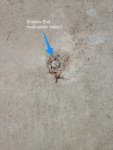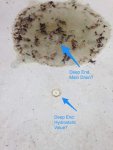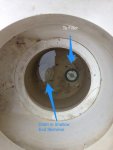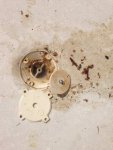Short story: I've drained my pool (reason listed below). My wife called me in a panic yesterday because two different co-workers warned that you "have to drain the pool correctly" and there is a valve or something you have to pay attention to or the pool can pop out. I'm assuming they are talking about the hydrostatic values. Not finding any posts that satisfied my curiosity/concern I thought I'd ask for help. I have three pictures below that show something on the bottom of the shallow end, the same thing in the deep end, near the main drain, and what appears to be some sort of extra plug that is in both the shallow and deep end skimmers:



My questions are two fold:
1) What in the world am I actually looking at?
2) Is there anything I really need to be concerned with while the pool is drained?
Now for the long story:
We bought our house three years ago and it just happened to come with a pool (we weren't actually looking for a pool). The pool had been covered and not opened for at least 3-4 years. Checking the township records I was able to find that the pool was built in 1979. It is a nice looking big (irregular 20x40) pool in good shape and about 9 ft deep in the deep end. The first year we had an LPS open it for us and make sure everything we needed was there and in working order, which thankfully it was. After working with the LPS for a few months and dutifully taking water samples to them every week, I stumbled upon TFP and haven't looked back. I've since done everything myself, checking water quality daily, using the recommended chemicals and eschewing the LPS, and opening and closing the pool on my own. Even replacing my filter pump and main filter valve. Keeping an eye on the water quality each day, I've been able to keep the levels exactly where I've wanted them.
The issue that we've had since opening the pool three years ago is scale, which wasn't surprising to me since it had been closed for so long. By the end of last year, the scale was so bad that you could not approach the side of the pool without actually cutting yourself, pretty much over the entire length and height of all sides. Over the last two seasons, I've done everything recommended here for dealing with the scale with the exception of using Jack's Magic Stuff. I talked to the LPS about my situation and inquired about an acid wash. They said they wouldn't even touch it because with the age of the pool, they didn't want the liability if they damaged the plaster. My plan was to open the pool this year and try Jack's Magic. By the middle of winter I decided I didn't want to take what was obviously going to be a lengthy time to try Jack's Magic and not have it solve my problem. So instead, I decided to open the pool early, drain it and actually sand off the scale.
I get this is the REALLY hard way to attack this problem, but I have to say it's actually going along faster and better than I expected. Sanding at 2 hour stretches at a time and refilling without a water truck, I'm still on pace to hopefully have the pool open for business by mid-June, only two weeks later than usual. So that's my whole story. Thanks for sticking through to the end of it. Any thoughts on the two questions I posed above in the short version of the story?
Thanks!
Tom



My questions are two fold:
1) What in the world am I actually looking at?
2) Is there anything I really need to be concerned with while the pool is drained?
Now for the long story:
We bought our house three years ago and it just happened to come with a pool (we weren't actually looking for a pool). The pool had been covered and not opened for at least 3-4 years. Checking the township records I was able to find that the pool was built in 1979. It is a nice looking big (irregular 20x40) pool in good shape and about 9 ft deep in the deep end. The first year we had an LPS open it for us and make sure everything we needed was there and in working order, which thankfully it was. After working with the LPS for a few months and dutifully taking water samples to them every week, I stumbled upon TFP and haven't looked back. I've since done everything myself, checking water quality daily, using the recommended chemicals and eschewing the LPS, and opening and closing the pool on my own. Even replacing my filter pump and main filter valve. Keeping an eye on the water quality each day, I've been able to keep the levels exactly where I've wanted them.
The issue that we've had since opening the pool three years ago is scale, which wasn't surprising to me since it had been closed for so long. By the end of last year, the scale was so bad that you could not approach the side of the pool without actually cutting yourself, pretty much over the entire length and height of all sides. Over the last two seasons, I've done everything recommended here for dealing with the scale with the exception of using Jack's Magic Stuff. I talked to the LPS about my situation and inquired about an acid wash. They said they wouldn't even touch it because with the age of the pool, they didn't want the liability if they damaged the plaster. My plan was to open the pool this year and try Jack's Magic. By the middle of winter I decided I didn't want to take what was obviously going to be a lengthy time to try Jack's Magic and not have it solve my problem. So instead, I decided to open the pool early, drain it and actually sand off the scale.
I get this is the REALLY hard way to attack this problem, but I have to say it's actually going along faster and better than I expected. Sanding at 2 hour stretches at a time and refilling without a water truck, I'm still on pace to hopefully have the pool open for business by mid-June, only two weeks later than usual. So that's my whole story. Thanks for sticking through to the end of it. Any thoughts on the two questions I posed above in the short version of the story?
Thanks!
Tom


